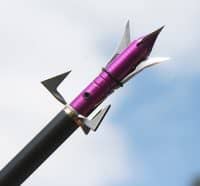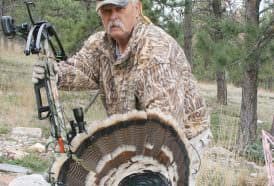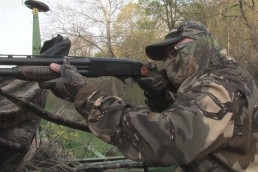Cross-cutting Spring Gobblers
SHARE THIS POST
Crossbowhunting spring gobblers can be risky business if you’re not set up with the right broadhead-tipped bolts.
With the exception of correct positioning and call selection, a very basic area that needs to be addressed, in terms of developing a successful crossbow turkey hunt, is the attention paid to the kill system your taking into the field.
At the tip of that crossbow bolt is the point where everything comes together, in terms of a kill shot that gets it done. Lacking some understanding and application of broadhead designs can and will lead to lost birds. Lost is waste as such, and no hunter worth his or her salt want to see a wounded bird flutter off or run, only to be lost to the fox or coyote down the line.
As a longtime turkey hunter who has covered just about every state over a 55-year period, I finally turned to the crossbow for most of my hunting partly because of the challenge involved over the rifle or shotgun—and for the fact that due to a work-related injury many years ago, the English long bow, recurve and pulley bow had to be set aside as such.

In South Dakota, a special permit is still required to use a crossbow, but with one in hand, the hunting opportunities are limitless in terms of getting carbon, steel and fletching on warm targets. It was with that background that I started taking game with this system 13 years ago, and I have racked up a significant number of successful hunts with the horizontal “stick and string system” of archery hunting.
There is an area of concern however, as applied to using bleeder types of equipment when taking game. For deer, I have always stayed with a large elk level broadhead designed with the primary cutting surface much like an old English Bodkin-style broadhead system, followed by a set of replaceable bleeders. In this case, Steel Force has been my complete go-to system, as this outfit will balance and rebuild my broadheads after a recovery from an animal or ground strike in our nasty rock country.
Thinking this was the way to go on all levels, I started out hunting Black Hills gobblers in spring and fall with a TenPoint Fusion, but got a quick lesson in the fine art of screwing up a shot. Broadheads, designed for double-lung or heart bleeding, don’t cut it for big tom turkeys. I have been surprised as to the little amount of information centering around the use of a proper game point when applied to taking turkeys with a bow, or in this case, crossbow system. With the loss of my very first solid hit on a tom, I realized that something had to change—and fast.
Shooting a broadside shot on a called gobbler that was far more interested in my decoy jake than me forted up at the base of a tree, my 18-yard square-on-side-plate lung shot just didn’t cut the deal at all. With a vital area about the size of a small fist, that bolt had missed the dead-bird mark and my tom was lost to the coyotes. The next morning, wet feathers were only left during my recovery.
An answer came a bit later in that year when hunting with a local coyote hunter and discussing the fact that my choice in equipment had not resulted in a very clean-killing approach to stick and string turkey hunting at all.
“Mechanicals, my friend,” my hunting buddy retorted.

He said trash the fixed blades and go to as large a mechanical two-blade as possible. He, like myself, had experienced exactly the same effect when applying a deer hunter’s fixed broadhead to turkeys. And with that, I went to searching for the best possible system I could find at the time.
The answer to the problem showed up when the massively broad bladed NAP, New Archery Products’ crossbow with a FOC 170 grain 3-inch cutting surface and 2-blade expandable design reached my mailbox. It was time for fall hunting, and I was setup in my ground blind on a local turkey-traveling route in the northern Black Hills. The NAP system came with a set of target points that carried an amount of grain weight as the 3-inch cutting expandable could. Therefore, I adjusted by Bushnell red dot sight for the increase in weight as applied to the big knife-edged system that was about to go into the field.
Are you enjoying this post?
You can be among the first to get the latest info on where to go, what to use and how to use it!
On the third day, a mature jake walked into my kill net, which was set at 15 yards by design. Again, I was not educated enough to shoot for the head or neck as I pulled for a straight, dead-center shot from the rear to the front, figuring to cut through the bird’s vitals with the hatchet-like FOC expandable killing tool. The bird took the bolt and hit and rolled off its feet, only to regain its footing and start running away. All I could do at that point, was keep an eye on the departing bird, and with some slight patches of remaining snow in the woods, track it to wherever he would end up running out of gas.
Recovering my bolt, I found that both large cutters had been sheered off the main hardened main shaft point. The bolt shaft was covered in thick, clear liquid, indicating a complete pass-through. It had only traveled another 10 yards beyond the point that my bird had taken the hit. To me, this meant that the turkey had been hit in some very tough tissue, and most likely had been not only hit in the vitals, but also had a split breastbone as well, if not worse.
I recovered him 85 yards downhill from my blind; I could not believe the ground the bird covered after taking that horrendous bolt strike. Turkeys are tough, and like so many critters, can take a pounding and flat out leave the area like nothing ever happened at all. The bird had bled out clean, and what could have been a lost game animal turned out well—due, for the most part, to the use of a mechanical, wide-surface-area-cutting NAP system. Needless to say, I was sold on “mechanical,” as applied to bowhunting turkeys.
The next significant event took place this past spring when TenPoint sent a sample of the new Wicked Ridge to me for testing. This new bow weighs in at 7 pounds, versus the 9 pounds carried by my TenPoint Fusion. The slightly smaller bow is fast to point and handling, and even with a shallow barrel structure, making use of a special hand guard takes away the risk of loosing a finger or worse when shooting under pressure.
Along with the test bow, came a complete set of Xecutioner mechanical crossbow broadheads by Datt Outdoors. These auto blades retained a 2 1/2-inch main blade cut with a razor point and a set of tri-posted secondary cutters behind the main set of blades—in effect, a very nasty system when deployed against a warm target. At 125 grain, these game blades would be massively lethal against a short-range gobbler that took a proper vital hit. A neck or head shot would be the rule afield.
On the second day of the South Dakota archery turkey season, I was set up in my ground blind with several gobbler decoys in place as I worked a deep draw with mouth calls 300 yards out in the hills. With first light, six hens approached the decoys, but they thought better, and pulled off heading away at a fast trot. Nothing happened for the next hour. Then, from the right side of the blind and complete to my blind side, two gobblers came rolling in fast and hard toward the smaller gobbler decoy. The second bird was larger; it came to a stop and hulled up his head, offering the perfect neck shot. I sighted at the base of his neck, just below his wattles and touched off the Wicked Ridge with its auto point mechanicals. In zero time flat, the bird 13 yards out was hit, down and bleeding a massive amount as it covered the surface of a limestone boulder even with the ground. It was over in a flash, and I don’t believe that my tom ever knew what hit him.
Upon examination of the mechanical broadhead, I observed that the main blades had been deployed with perfection: The tip blade had been cocked to the side from bone contact and the rear-mounted reverse tri-point blades were clogged with feathers—an indication a slowing action was produced by the system’s design. The crossbow bolt was completely intact and usable for a second run on turkeys, if and when required.
I believe that what this small sample-size study shows, is that there are some very effective systems set up for crossbow shooters when taking on varied targets, like turkeys. Game with small, tightly-packed vitals and not a whole lot of blood flow through much of their body tissue demand more attention to detail, especially when selecting the correct tools for the task at hand. It’s a learning curve here, and I just got an eyeful of a real case study.
L.P. Brezny has worked in research and development across the shooting industry for 37 years. He has developed and marketed systems for 12 gauges, designed ammunition for Winchester and Federal Cartridge, designed separator quiet slugs, shotshells and one-choke do-it-all systems. Brezny was the first ballistics writer to measure shotgun pellets in flight to ranges as great as 100 yards. He has published three books on shooting (Gun Digest Books), and is completing a fourth on long-range rifle applications. He has published hundreds of articles on sending rounds downrange.
MWO
SHARE THIS POST
Did you enjoy this post?
You can be among the first to get the latest info on where to go, what to use and how to use it!



